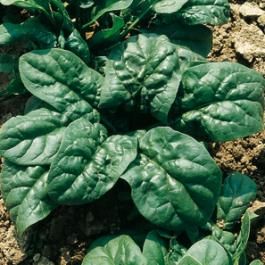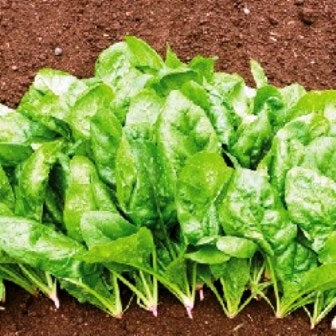BUTTERFLY SPINACH - sp11
Have a question?

BUTTERFLY SPINACH - sp11
Dettagli
Species: S. olareacea
Family: Chenopodiaceae.
English: Spinach; Spanish: Espinaca; German: Spinat; French: Epinard;
 Origins.
Origins.
Spinach is a vegetable known since ancient times and arrived in Europe from Iran around the year 1000 and from Spain it spread to other European countries, then passing to America after 1500.
In Italy its cultivation is widespread in all regions, in particular in Lazio, Tuscany, Campania, Veneto and Piedmont.
Its cultivation in greenhouses for winter production is also widespread in the North. Production is concentrated in the autumn and winter months.
Approximately 100,000 tons are produced throughout the peninsula. per year and mainly intended for the industry to obtain frozen and dehydrated foods. Spinach is highly appreciated as a cooked vegetable, it has a dry matter content of 10% with 3.7% proteins; its content of vitamins and mineral salts is high. The high amount of iron is a myth.
Spinach is an annual herbaceous plant, with a red tap root near the collar. The basal leaves are fleshy, equipped with a 5-10 cm long petiole and a smooth or bullous edge 10-20 cm long; they are gathered together in a rosette in number of 20-30 before the release of the branched floral scape.
The flowers are small, greenish, gathered in axillary glomeruli for the female ones and in spikes for the male ones; it is a dioecious species, but there are also types with intermediate sexuality depending on the cultivars and environmental conditions, which can influence sexual expression. Male plants are characterized by flower stems without leaves, female plants have complete leaves up to the ends of the stems.
Based on the shape of the fruit, two subspecies are distinguished:
– Spinacia olracea inermis Moench (= glabra Mill), with smooth sub-round fruits; it is the most widespread type in cultivation, with numerous cultivars;
– Spinacia oleracea spinosa Moench, with angular or thorny fruits; few varieties are known (Hollandia, Amsterdam and Cavallius) and, although they have good rusticity and resistance to cold, they are not widespread in Europe, and almost exclusively for the canning industry.
Environmental needs
Spinach is a species with low thermal requirements and good tolerance to cold in the rosette phase. It is a long-diurnal plant, with rapid induction into flowering at day lengths exceeding 14 hours (May-August).
It requires fresh, permeable and well-drained soil, with a pH above 6.5. It has good tolerance to high salinities. Nutritional needs are also medium.
For rapid growth it requires high and constant humidity conditions; therefore it is advisable to resort to irrigation in the event of adverse weather conditions for sowing and during the early stages of growth also to avoid pre-flowering phenomena.
Variety
The distinction between the numerous cultivars can be made based on the destination of the product (market or industry), the shape of the leaf blade (wide, rounded, elongated), the intensity of the blistering and the color (green or dark green), the habit of the head (erect or prostrate), but at the cultivation level, what is especially important is the reaction to the length of the day and the resistance to rising to seed, which influence the possibility of cultivation in the different periods of the year; there are two categories:
1. Autumn-winter cultivars: they are suitable for cultivation in short-day conditions, have high vigor and good resistance to cold, but go to seed quickly in long-day conditions; they are sown at the end of summer-autumn (August-October) for autumn-winter production. (The Matador is very well known).
2. Spring-summer cultivars: they adapt to long-day cultivation, as they are slow to set seed; they are sown in spring (March-April) for spring-summer production. (America and The Summer Giant)
Cultivation:
Spinach, in relation to its short cycle, is frequently cultivated as an intercrop in the autumn-winter period with sowing in August-September; finds the best phytosanitary conditions when 4-year rotations are observed; spring crops are also grown especially in the Centre-North.
After having plowed the soil to 20-23 cm, refinement and arrangement is carried out in porches (15 cm raised flowerbeds approximately one meter wide and separated by passages of 35-40 cm) which are very important in autumn crops to avoid water stagnation. waterfall.
Sowing can be done by broadcast or by machine, in rows 20-30 cm apart, with burial at 1-2 cm depth; the crop density varies depending on whether the crops are intended for the market (19-22 kg/ha of seed to achieve, after thinning, a density of 35-50 plants per square meter) or for industry (30-40 kg/ ha of seed to achieve a density of 200-250 plants per square meter; the high density favors the upright growth of the plants, which is highly requested for mechanical harvesting).
The consecutive works (in addition to thinning) are weeding, irrigation and, considering its short cycle, a treatment with cornolet manure and one with cornosilica.
Collection and production
The harvest takes place 40-60 days after sowing in spring crops; the entire plant can be removed or harvested; the root is cut just below the leaves; in industrial plants mechanical harvesting is very widespread. Production is around 200 quintals per hectare. The harvested spinach, removed from the yellowed leaves, is placed in 10-15 kg boxes and immersed in water to remove the soil and improve the freshness of the leaves. As regards the conservation of the fresh product, there are maximum limits of 15 days by keeping the product in the fridge at 0°C and 95% relative humidity.
Adversity and parasites
A fairly rustic plant, there are not many parasites capable of attacking it in the autumn-winter period, when temperatures are relatively low; but be careful to always perform the correct rotations.
Among the plant parasites that cause root and collar rot we remember Pythium ultimum and Rhizoctonia solani.
Even downy mildew (peronospora farinasa f. sp. spinaciae) can be harmful in conditions of high humidity and temperatures between 8 and 18°C. During the summer period, anthracnose, cladosporiosis and fusarium wilt are more harmful to seed crops. In this case, horsetail decoction is a good preventative.
Among the viruses transmitted by aphids that can attack spinach are the cucumber virus, the mosaic virus and the chard yellow virus.
The most harmful animal parasites include, in addition to aphids, noctules, snails and the Pegomya hyoscyami fly.
Various combinations with spinach
Spring associations.
It should be sown early in spring, in rows 40 cm apart and leaving the inter-row space free for planting potatoes, tomatoes or radishes. When the growth of spinach risks excessively shading the other plants, this will be cut and left on the ground as a mulch layer, useful above all for reducing water evaporation and, subsequently, for enriching the soil with organic substance.
The plants, cut 2-3 cm deep, will no longer be able to emit leaves and the remaining roots, tender and easy to decompose, will enrich the soil with organic substance. This model can also be repeated the following year by sowing spinach in the rows where other vegetables had been planted the previous year.
Early potato and spinach
This is a favorable combination due to the stimulating effect that the root exudates of the spinach have on the potato.
Spinach plants will be sown in the center of the field and on the external edges while potato plants will be sown in the remaining part.
Tetragony.
New Zealand spinach or tetragonia is a minor leafy vegetable that is used like spinach in the summer. It is an annual herbaceous plant, native to New Zealand and Australia, introduced to Europe by the English in the 18th century.
It has a succulent herbaceous stem more than a meter high with many ramifications; the alternate leaves are smooth and fleshy with a short petiole (1-2 cm) and a triangular edge. The plants are hermaphroditic and produce hardened, angular, horned axillary fruits that are used as seed.
Considering the high thermal requirements, it can only be cultivated in the spring-summer period with sowing in May in open air. Despite being a rustic plant that is easy to adapt, it produces abundantly only in fertile and well-fertilized soil with mature manure compost with frequent and abundant irrigation.
Harvesting begins approximately 70 days after sowing by detaching the basal and axillary leaves along the stem; even the tips of the branches can be cut off by half at each harvest and used like leaves: In favorable conditions the harvest, if scaled up throughout the summer, provides production of 200 q/ha of leaves and stems.
No parasites or particular adversities are known.


